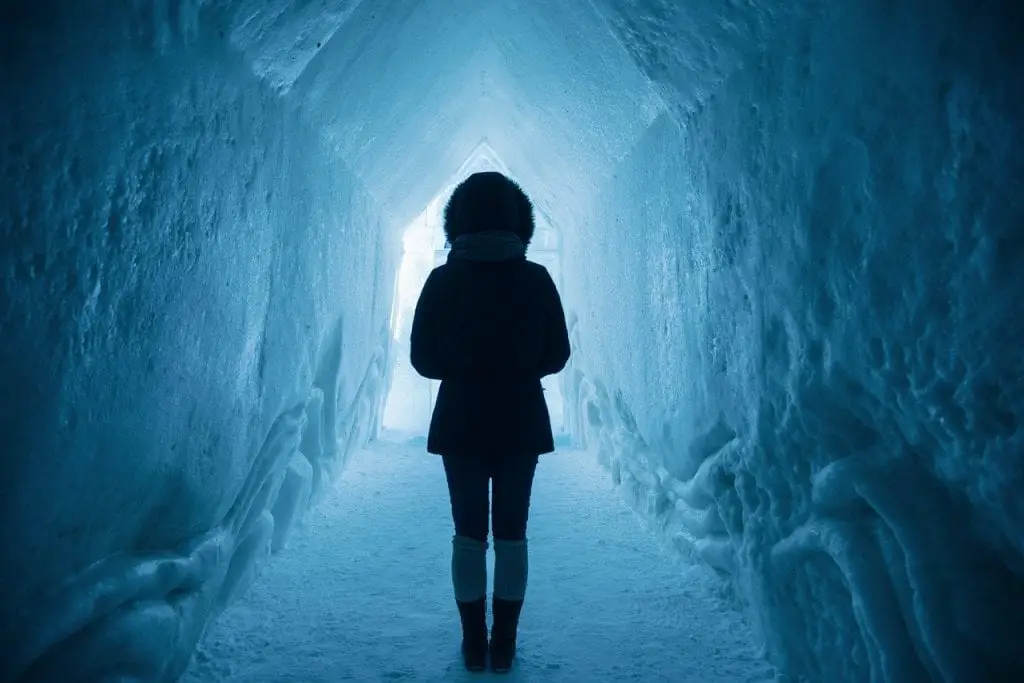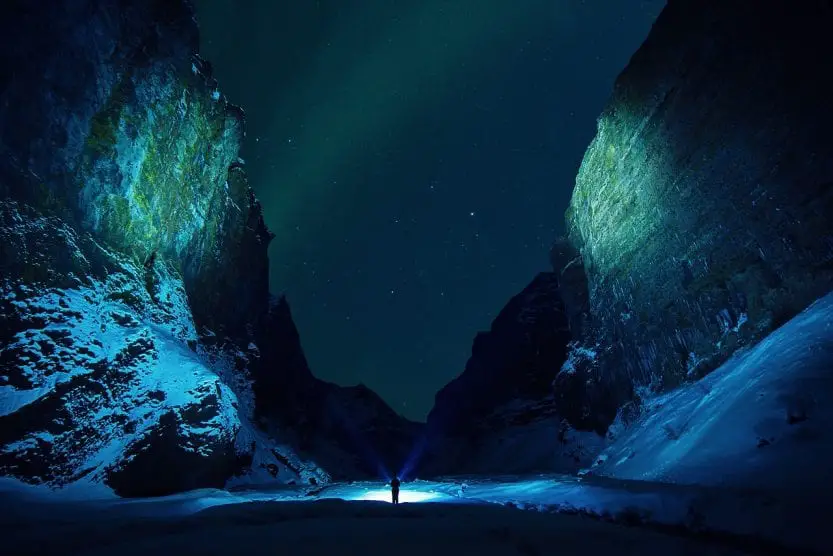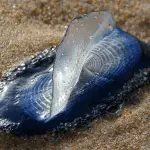When we normally think of ice we assume it to be with. Then one can wonder why the ice in many Ice caves turns into blue, gray, or black in Iceland?
Depending on how the ice was formed the cave can even be crystal clear or glass and everything in between. They also have a tendency of being different colors. No, we do not mean that they have every color present under the sun. But they do have staggering shades of blue and gray.
How does ice turn blue?
This usually happens when all the crystal in glaciers get compressed beneath their own weight for hundreds or thousands of years and the air inside them comes out in the form of bubbles. In this process, the ice enlarges and forms blue ice. When a glacier undergoes such a transformation one can actually the whole glacier emits light like a quartz crystal. If seen from afar the glacier looks light blue in color.
In most cases, the blue looks opaque and almost solid like a crystal. Some glaciers can have a deeper and richer color. In these mostly algae are trapped which impart the color. Some glaciers have a very deep blue color that looks almost violet. This is due to the fact that the color runs very deep in these glaciers or caves.
Defying Norms
The caves found in Iceland defy the conventional norms or topology and ice cave formation. Some are so ornate in design that it is hard to think that these were made due to certain conditions being met. Rather than someone carved them altogether. Most of these formations have left the scientists baffled for many years as they squirm to find some rhyme and reason behind their formations.
The Crystal Cave in Breidamerkurjökull is present in an outlet glacier from Vatnajökull and is famous for its deep turquoise color. Other caves are also present which are gray and black in color. Langjökull Ice Cave is also another example of a recently formed ice cave which is mostly famous for the different colors that it has. One can find deep and dramatic shades of blue and white throughout the cave. In some places in the cave, you can see concentric circles that alternate between blue and white while zebra stripe kind of patterns can also be observed. Blue objects like crystals can also be seen distinctly sometimes. This is due to the variation of the color and distribution in the ice.
Black Ice
Not very far from the Crystal Lake is a Black ice cave known as the Dark Rubin in Iceland. Due to the black ice, the place is actually quite dark and it is not a very popular tourist destination. The cave can only fit about 30 people at a time and has very poor visibility inside.
Another cave can be found in Mýrdalsjökull Glacier near the Katla Volcano. This is even darker than the one mentioned before.
Touring In an Ice Cave
While admiring the beauty of one such cave it is easy to forget that you are literally walking on ice. Make sure you have someone with you when you explore these caves and have the right equipment. Having someone more experienced than you is the key here and follow the guidelines. These caves are inherently dangerous and a mistake by one can lead to tricky situations for all.

Seasonal Affair
Although flights to Iceland are now available throughout that does not mean that the caves are open for exploration year-round too. Iceland is a popular tourist destination for the most part of the year but if you want to visit the caves the best time is in the winter. That means the caves are open for tourists from November till March. This is the peak season when people come to bask in the glory of these caves. Also, at this time of the year, the ice is rock solid which makes it safer to explore these caves.
Ice caves are wonders of nature. These blue objects on Earth are part of the unexplained formations that humans still need to decode. Most of the caves have a very different vibe and are mostly mesmerizing in nature. The sheer natural beauty will leave you in their awe and the different shades are a sight to behold. These blue objects of wonder are masses of raw ice from the start of finish. Having a walk inside them is an experience of a lifetime.
What makes them even more unique is the fact that they are ever-changing in nature. You might visit a cave one season and if you visit it after a few years it would have changed significantly. Even the size of the formation changes along with all the intrinsic patterns present inside. For example, in 2016 a Blue ice cave came into existence and was named the Blue Diamond Cave. It was so small that it could only accommodate 16 people at once while the Crystal Cave can house 100 people with ease.
The experienced tour guides study and map these glaciers year after year just before the season so that they can discover new formations. And make note of the changes that have happened. This is also to ensure the safety of all the people.
How they came into existence
Like the floating and ever-fleeting glaciers we have already established the fact that these caves are also ever-evolving and changing. This can be mainly attributed to the fact that in summer the glaciers melt while in winters they freeze again. The melted water drains downwards through all the cracks and crevices. They reach the bottom of the glacier and end up forming rivers underneath. This ensures that the glacier is free to float wherever the current takes it. These internal channels in the ice are responsible for the movement of glaciers at large and also the reason ice caves change so frequently.
The sub glacial flow triggers geothermal warmth. The glacial flow and the hydrothermal flow of water also cause the ice to take shape accordingly. Since this has been established it is still impossible to figure whether a cave was formed by geothermal or sub glacial activity.
When its cold in the winters ice hardens and the melting water stops creeping down to the bottom. In the absence of this melted water, the tunnels transform into ice, and they are so huge that they may be considered to ice caves.
Ice Caves vs Glacier Caves
These blue objects of beauty can someone cause some confusion in how to be classified. For example, even though they are made of ice all the Ice Caves in Iceland are technically glacier caves as they are formed inside the glaciers entirely. But the name Ice Cave is way more popular. Ice Caves are literally caves with a lot of ice in them so their formation has nothing to do with the name.
Proper Cave Etiquette
Most people are amazed by what is inside the cave. Some intricate formations will also be present there. It is best not to touch anything that may break easily. Also, a crack can lead to a series of events that may be dangerous for everyone present inside the cave. Do not act hastily and under no circumstances run or stomp your feet in the ground.
Always follow guidelines laid down by the tour guide and be respectful of the fact that even one person’s action can endanger the whole crew and tourists present there. Follow their instructions at all times to have the best experience.
Make sure you pay heed to all the signs present inside a cave. They are there for a reason. Nature might be beautiful to look at but can turn fierce in a split second. These blue objects are not an exception. A cracked ice floor can mean imminent complications for everyone.
If someone brags about violating the safety norms do not pay heed to them as they had successfully endangered the lives of a group of people for no reason.
There is a famous Dragon Glass ice cave that resembles the themes and aesthetics of Game of Thrones and is a must-watch for everyone.
Conclusion
Even before you reach the cave you must tread very carefully. Keep in mind that you are essentially walking on a sheet of ice that has freezing water underneath. These adventures are very aesthetically please but keep yourself safe at all costs. Listen to the guidelines and try to read up on the cave and the trek beforehand. Try to be aware of the situations in the cave and do not let your adrenaline rush get the best of you as haste actions can cause complications on these ice surfaces. Your tour guide will be happy to answer and explain all your questions and can also guide you to the best formations. We would recommend having a great rapport with him from the start to make the best of these blue objects of natural beauty.



